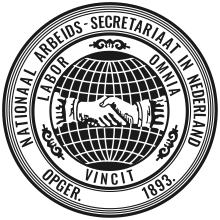National Labor Secretariat
Nationaal Arbeids-Secretariaat | |
 | |
| Predecessor | Social Democratic League |
|---|---|
| Founded | 1893 |
| Dissolved | 1940 |
| Location | |
| Affiliations | Red International of Labor Unions (1922-1927) |
| Part of a series on |
| Syndicalism |
|---|
 |
The National Labor Secretariat (Dutch: Nationaal Arbeids-Secretariaat, NAS) was a trade union federation in the Netherlands from 1893 to 1940.
Early years
In the late 1880s and early 1890s the idea that trade unions should no longer be branches of the
After the SDB split into the revolutionary Socialist League and the parliamentary Social Democratic Workers' Party (SDAP) in 1894, both remained members and the NAS did not get involved in the conflict between them, but the relations between the NAS and the parties soon deteriorated to the point that in 1896 both the Socialist League and the SDAP were expelled from the NAS, leaving only unions in the organization.[1]
By 1896 thirteen national and 16 local unions were part of the NAS. Conflict soon ensued over the distribution of financial means within the NAS. All unions in the federation had one vote, no matter what their size, but financial contributions to the union funds were on a per capita basis. Moreover, the NAS supported in principle all strikes - be they by NAS members or by non-affiliated unions or even individuals, because all strikes were seen as a learning experience for the working class. The financial shortage that resulted from this as well as increasing anarchist tendencies in the NAS soon led many of the larger unions to leave the organization. By 1903, only fifteen national, but 61 local organizations were part of the NAS.[2]
Pre-WWI period
1903 saw relations between the NAS on the one hand and the SDAP and many of the large non-NAS unions deteriorate further. A successful general strike, which started in January 1903, led to strict laws prohibiting such strikes. A "Resistance Committee" consisting of the NAS, the SDAP, and the General Diamond Workers' Union of the Netherlands (ANDB), the largest non-NAS union in the country, soon fell apart. In late 1903, the SDAP leader Pieter Jelles Troelstra then claimed the NAS was "done for". In 1906, the Dutch Confederation of Trade Unions (NVV) was founded as an SDAP-loyal union federation. It had more members than the NAS from the start.[3]
In the following years the NAS slowly turned to
Post-WWI period
Like most European syndicalist unions, the NAS saw its membership boom after
The NAS, however, split from the RILU in 1927 due to fear of Moscow control. After the NAS had seceded from the RILU, it was reaching to the German revolutionary trade-unions and the international revolutionary-syndicalism, which opposed soviet politics. A merge with the NSV failed because the NSV wanted to return to a pure independent foundation, while the NAS executive thought that political and economic struggle were intertwined due to increasing state intervention. Eventually, the communist opposition within the NAS was expelled. As a counterpart of the communist network of unions, the NAS founded additional organizations and an innate political party, the RSP, in 1929. [6]
After 1920, the membership of the NAS waned reaching 13,000 in 1924. Its members were now primarily transport workers, construction workers, and Amsterdam municipal employees. In 1927, the NAS broke with the Communist Party and many of the union's leaders helped form the
Footnotes
- ^ Marcel van der Linden, "The Many Faces of Dutch Revolutionary Trade Unionism," in Marcel van der Linden and Wayne Thorpe (eds.), Revolutionary Syndicalism: An International Perspective. Aldershot, England: Scolar Press, 1990; pp. 46-47.
- ^ van der Linden, "The Many Faces of Dutch Revolutionary Trade Unionism," pp. 47-48.
- ^ van der Linden, "The Many Faces of Dutch Revolutionary Trade Unionism," pp. 48-49.
- ^ van der Linden, "The Many Faces of Dutch Revolutionary Trade Unionism," pg. 49.
- ISBN 978 90 5972 227 9
- ISBN 9789 08555 1027
- ^ van der Linden, "The Many Faces of Dutch Revolutionary Trade Unionism," pp. 51-54.
